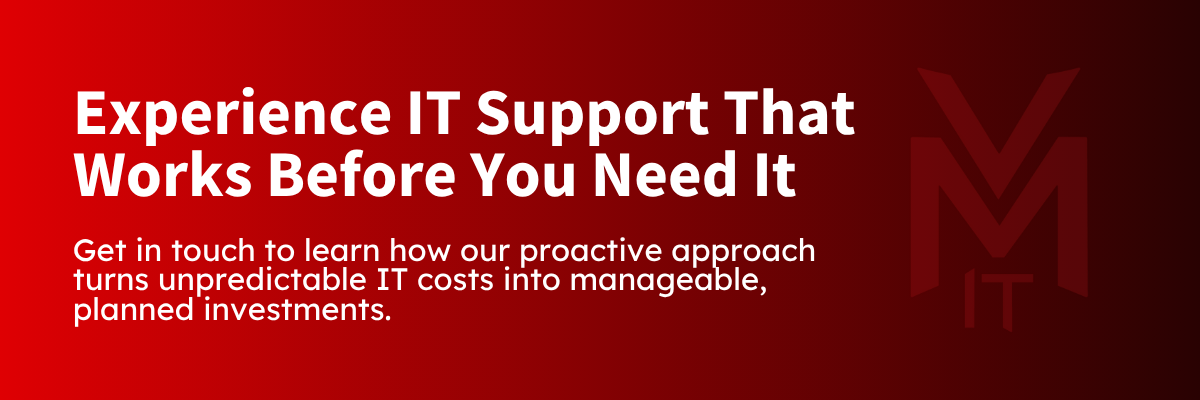When your business technology fails, every minute of downtime costs money, productivity, and potentially customer trust. The question facing every Norfolk business owner is: should you wait for problems to occur or invest in preventing them altogether?
It sounds simple when you put it that way. Yet many local businesses are still settling for IT support that leaves them constantly putting out fires. We think that’s mainly down to a lack of awareness – something we can do our part to change.
Today, we’re breaking down the difference between a proactive and reactive approach to IT.
What Is a ‘Proactive’ vs ‘Reactive’ IT Support Strategy?
Essentially, ‘proactive’ and ‘reactive’ strategies are two different approaches to the same problem. One looks to act when a situation or set of circumstances arises, and the other attempts to prevent those issues arising in the first place.
What Does Reactive IT Support Look Like?
Reactive IT support follows a “break-fix” approach – ‘fixing’ technology only after it’s ‘broken’ (in other words, when it’s already impacted your business operations). This traditional model, which you might know better as “paying-as-needed,” involves:
- Waiting for systems to fail before taking action
- Responding to emergencies as they happen
- Applying immediate solutions to restore functionality
- Dealing with each incident as an isolated event
Depending on the incident and the expertise of the person(s) responding, resolution times (and effectiveness) will vary greatly.
It’s a more high-risk approach with fewer safety nets in place – a bit like having a fire department that comes to put out blazes but doesn’t bother installing smoke alarms or teaching your team how not to start a fire.
So Why Do Businesses Still Choose Reactive IT?
For businesses operating on tight budgets, reactive support might seem attractive because you only pay when problems arise. However, this apparent cost advantage often proves misleading when you factor in the true cost of downtime and emergency interventions.
| Reactive Support Costs | Proactive Support Investment |
| Emergency call-out fees (often premium rates) | Predictable monthly monitoring fees
|
| Extended downtime costs (lost productivity) | Planned maintenance during convenient hours
|
| Potential data recovery expenses | Bulk purchasing advantages for scheduled replacements |
| Rush shipping for replacement parts | Reduced insurance premiums due to better risk management |
| Stressed staff and frustrated customers | Improved staff productivity and customer satisfaction |
What Is Proactive IT Support?
Proactive IT support takes a prevention-first approach, anticipating problems before they disrupt your business. This methodology focuses on:
- Continuous monitoring of system health and performance
- Regular maintenance to prevent issues from developing
- Strategic planning for technology upgrades and replacements
- Implementing robust backup and disaster recovery solutions
We’re one of the IT support providers in Norwich that champions proactive services because we’ve seen the measurable benefits they deliver.
What Are the Advantages of a Proactive IT Strategy?
- Enhanced System Reliability: By monitoring your technology 24/7, potential issues are identified and resolved before they impact your operations.
- Reduced Total Downtime: Minor issues are addressed during planned maintenance windows rather than during critical business hours.
- Predictable IT Costs: Fixed monthly fees replace unpredictable emergency call-out charges, making budgeting easier.
- Improved Strategic Planning: Regular assessments help you make informed decisions about technology investments and upgrades.
- Better Disaster Recovery: Comprehensive backup strategies and tested recovery procedures ensure business continuity even when the worst happens.
The Technology Behind Proactive Support
Modern proactive IT support relies on sophisticated monitoring and management tools that provide comprehensive oversight of your technology infrastructure. We use ConnectWise, which gives us capabilities like:
Remote Monitoring Systems:
- Continuous tracking of hardware performance metrics
- Automated alerts for potential issues before they cause failures
- Real-time analysis of system health across your entire network
- Predictive analytics to identify components nearing end of life
Automated Maintenance Tasks:
- Regular software updates and security patches
- System optimisation and cleanup procedures
- Backup verification and testing protocols
- Performance tuning based on usage patterns
Comprehensive Documentation:
- Detailed records of all equipment and configurations
- Historical performance data for trend analysis
- Incident tracking and resolution documentation
- Strategic planning insights based on system evolution
This technology enables our team of IT support providers in Norwich to deliver unprecedented service levels, often resolving issues before our clients even realise they exist.
Real-World Impact: A Comparative Example
Let’s examine how these approaches differ in practice using a common scenario – a slow business computer:
| The Reactive Approach | The Proactive Approach |
| Employee reports computer running slowly | Monitoring software establishes baseline performance metrics |
| IT technician connects remotely to diagnose the issue | System automatically detects declining drive performance |
| Hard drive failure is discovered, requiring immediate attention | Alert is generated before any noticeable impact on operations |
| Computer must be brought to the service centre for repairs | Proactive IT support team contacts client to schedule maintenance |
| Business operations are disrupted while waiting for resolution | Replacement is planned during convenient downtime |
| Data recovery may be needed if backups aren’t current | Work is completed with minimal business disruption |
| Total downtime: 1-3 days (depending on parts availability) | Total downtime: 2-4 hours (during scheduled maintenance) |
The difference is clear: proactive support transforms a potential crisis into a planned maintenance event, dramatically reducing both downtime and stress.
Choosing the Right Approach for Your Business
While proactive IT support offers clear advantages, every business is different. The right option for you depends on your specific circumstances.
Proactive support is ideal for:
- Businesses with critical technology dependencies
- Organisations handling sensitive customer data
- Companies with remote or hybrid workforces
- Businesses experiencing rapid growth
- Operations that cannot afford extended downtime
Reactive support might work for:
- Very small businesses with minimal technology needs
- Organisations with dedicated internal IT staff
- Businesses with non-critical technology requirements
- Companies with extremely tight budgets
However, as technology becomes increasingly central to business operations, most Norwich businesses are finding that proactive IT support provides better value and peace of mind.
Long Story Short? Prevention Really Is Better Than Cure
The choice between proactive IT support and reactive IT support ultimately comes down to whether you prefer to invest in prevention or pay for repairs. While reactive support might seem less expensive upfront, the true cost includes downtime, lost productivity, and the stress of dealing with unexpected technology failures.
For businesses looking to thrive, a proactive approach provides the stability and reliability needed to focus on what matters most: serving your customers and growing your business.
Ready to experience the difference first-hand? Book a call with VMIT today to discuss your IT needs.
VMIT’s investment in advanced monitoring and management tools was supported by the New Anglia Growth Through Innovation Fund, part-funded by the European Regional Development Fund, enabling us to deliver cutting-edge proactive support services to Norfolk businesses.


